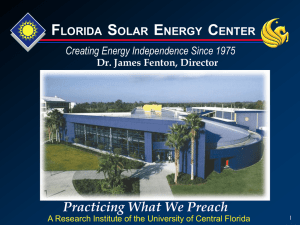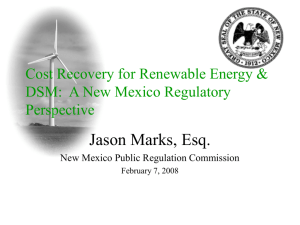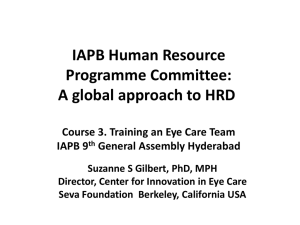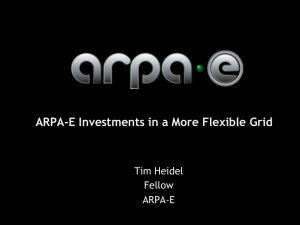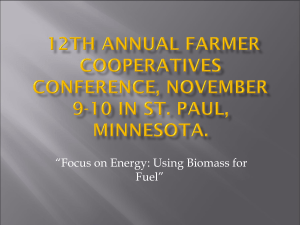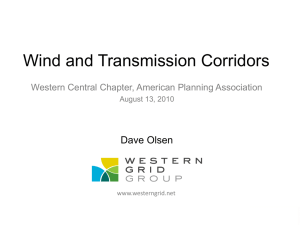Wind Energy Update Larry Flowers National Wind Technology Center, NREL April, 2010
advertisement
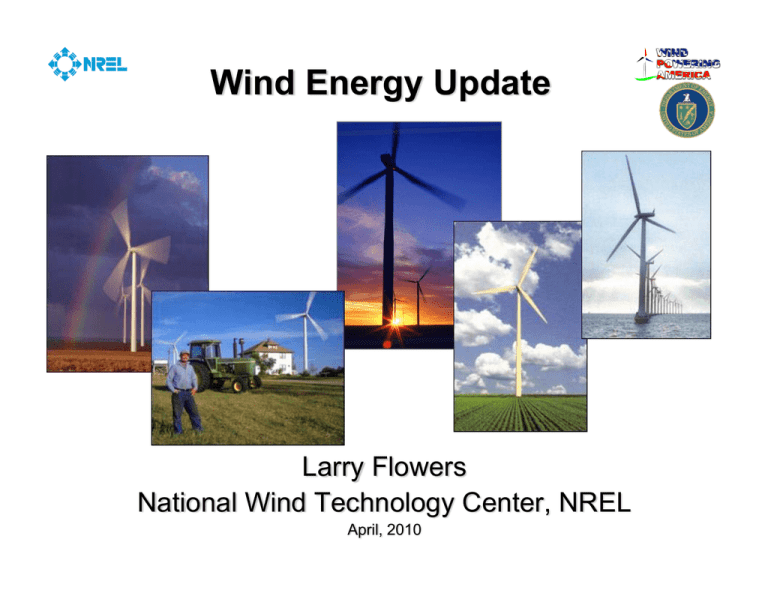
Wind Energy Update Larry Flowers National Wind Technology Center, NREL April, 2010 US Installed Wind Capacity U.S. Wind Industry 4Q 2009 Source: AWEA, updated through 4Q 2009 Geographic Spread of Wind Projects in the United States Is Reasonably Broad U.S. Wind Manufacturing Wind Is a Major Source of New Generation Capacity Additions: Wind Contributed 42% of New Additions in the US in 2008 • Wind was the 2nd-largest resource added for the 4th-straight year Wind Power in Queues (MW) Washington 5,831 Oregon 9,361 Montana 2,327 Idaho 446 Wyoming 7,870 Nevada 3,913 North Dakota 11,493 South Dakota 30,112 Nebraska 3,726 Utah 1,052 California 18,629 Arizona 7,268 Colorado 16,602 New Mexico 14,136 Kansas 13,191 Minnesota 20,011 Wisconsin 908 Iowa 14,569 Maine 1,398 NH 396 Michigan 2,518 New York 8,000 Penn. 3,391 IN Ohio Illinois 8,426 3,683 WV 16,284 1,045 VA 820 Missouri 2,050 Oklahoma 14,677 Arkansas 210 Texas 63,504 VT 155 RI 347 MA 492 NJ 1416 DE 450 MD 810 Under 1000 MW 1,000 MW-8,000 MW Over 8,000 MW Total 311,155 MW Source: AWEA Wind Has Been Competitive with Wholesale Power Prices in Recent Years • Wholesale price range reflects flat block of power across 23 pricing nodes • Wind power prices include sample of projects built from 1998-2008 Even Among More-Recent Projects, Wind Was Competitive in Most Regions in 2008 Note: Within a region there are a range of wholesale power prices because multiple wholesale price hubs exist in each area (see earlier map) Comparative Generation Costs 100 90 80 Wholesale Price Range for Flat Block of Power Average Price of Wind Power With PTC 60 50 40 30 20 Operating Cost of Natural Gas Combined Cycle 10 Source: LBL 2008 2007 2006 2005 2004 2003 2002 2001 2000 1999 1998 1997 1996 1995 1994 1993 1992 1991 0 1990 2008$/MWh 70 CO2 prices significantly increase the cost of coal Levelized Cost of Electricity (2010) vs. CO2 Price 140 130 2006$/MWh 120 Coal PC Coal IGCC Coal IGCC w/CCS Gas CC Nuclear Wind Class 6 Wind Class 4 Wind Offshore Class 6 110 100 90 80 70 60 50 0 10 20 30 40 Carbon Price ($/ton CO2) 50 Renewable Portfolio Standards www.dsireusa.org / February 2010 WA: 15% x 2020* MN: 25% x 2025 MT: 15% x 2015 (Xcel: 30% x 2020) MI: 10% + 1,100 MW ND: 10% x 2015 OR: 25% x 2025 (large utilities)* VT: (1) RE meets any increase in retail sales x 2012; (2) 20% RE & CHP x 2017 SD: 10% x 2015 WI: Varies by utility; 10% x 2015 goal NV: 25% x 2025* IA: 105 MW CO: 20% by 2020 (IOUs) 10% by 2020 (co-ops & large munis)* CA: 33% x 2020 KS: 20% x 2020 UT: 20% by 2025* + 1% annual increase CT: 23% x 2020 PA: 18% x 2020† NJ: 22.5% x 2021 VA: 15% x 2025* MD: 20% x 2022 DC NC: 12.5% x 2021 (IOUs) 10% x 2018 (co-ops & munis) NM: 20% x 2020 (IOUs) RI: 16% x 2020 WV: 25% x 2025*† MO: 15% x 2021 AZ: 15% x 2025 (Class I RE) NY: 29% x 2015 OH: 25% x 2025† IL: 25% x 2025 NH: 23.8% x 2025 MA: 15% x 2020 x 2015* 5% - 10% x 2025 (smaller utilities) ME: 30% x 2000 New RE: 10% x 2017 DE: 20% x 2019* DC: 20% x 2020 10% x 2020 (co-ops) TX: 5,880 MW x 2015 HI: 40% x 2030 29 states + State renewable portfolio standard State renewable portfolio goal Solar water heating eligible Minimum solar or customer-sited requirement *† Extra credit for solar or customer-sited renewables Includes non-renewable alternative resources DC have an RPS (6 states have goals) Environmental Benefits • • • • • No SOx or NOx No particulates No mercury No CO2 No water Source: NOAA Source: NOAA Idaho – Annual Average Wind Speed at 80 m
